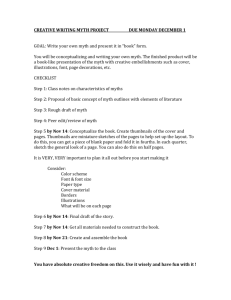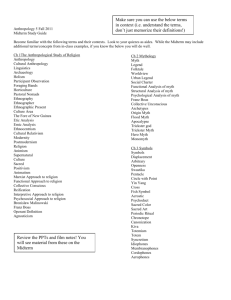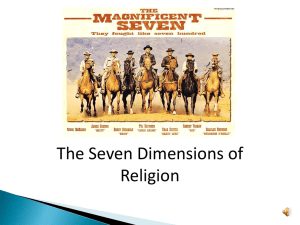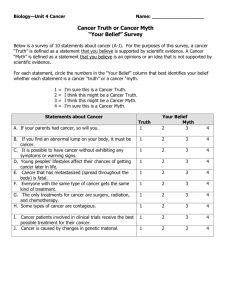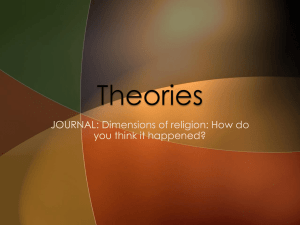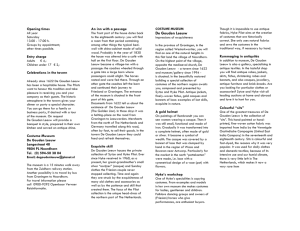INTRODUCTION TO RELIGIOUS STUDIES Religious Studies 100
advertisement
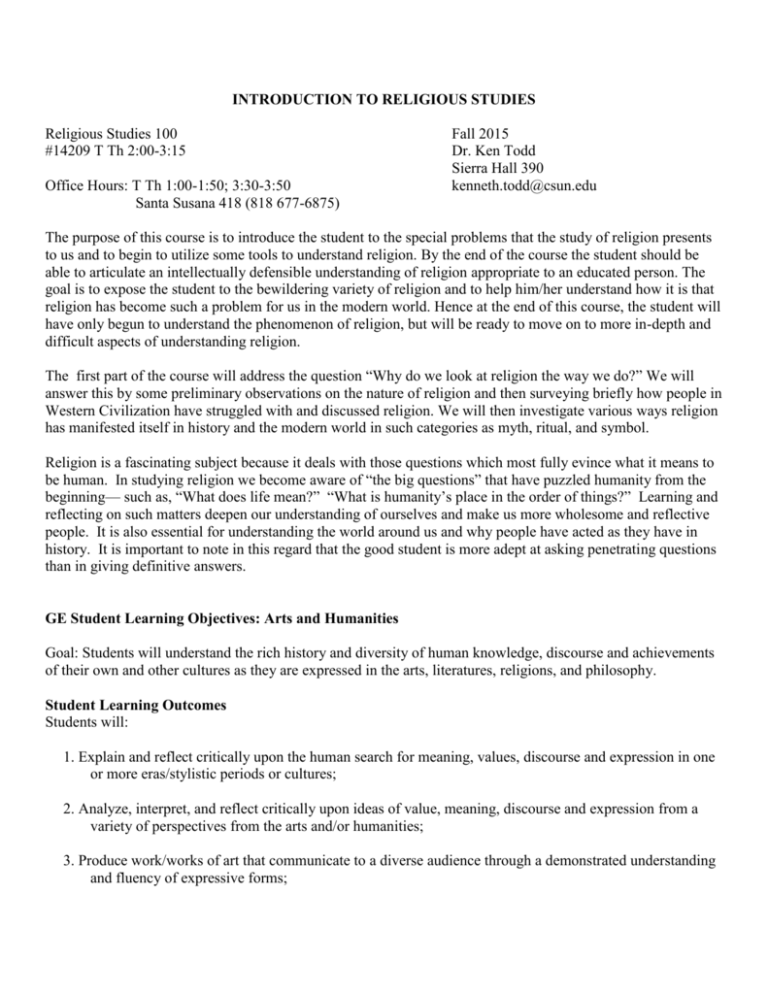
INTRODUCTION TO RELIGIOUS STUDIES Religious Studies 100 #14209 T Th 2:00-3:15 Office Hours: T Th 1:00-1:50; 3:30-3:50 Santa Susana 418 (818 677-6875) Fall 2015 Dr. Ken Todd Sierra Hall 390 kenneth.todd@csun.edu The purpose of this course is to introduce the student to the special problems that the study of religion presents to us and to begin to utilize some tools to understand religion. By the end of the course the student should be able to articulate an intellectually defensible understanding of religion appropriate to an educated person. The goal is to expose the student to the bewildering variety of religion and to help him/her understand how it is that religion has become such a problem for us in the modern world. Hence at the end of this course, the student will have only begun to understand the phenomenon of religion, but will be ready to move on to more in-depth and difficult aspects of understanding religion. The first part of the course will address the question “Why do we look at religion the way we do?” We will answer this by some preliminary observations on the nature of religion and then surveying briefly how people in Western Civilization have struggled with and discussed religion. We will then investigate various ways religion has manifested itself in history and the modern world in such categories as myth, ritual, and symbol. Religion is a fascinating subject because it deals with those questions which most fully evince what it means to be human. In studying religion we become aware of “the big questions” that have puzzled humanity from the beginning— such as, “What does life mean?” “What is humanity’s place in the order of things?” Learning and reflecting on such matters deepen our understanding of ourselves and make us more wholesome and reflective people. It is also essential for understanding the world around us and why people have acted as they have in history. It is important to note in this regard that the good student is more adept at asking penetrating questions than in giving definitive answers. GE Student Learning Objectives: Arts and Humanities Goal: Students will understand the rich history and diversity of human knowledge, discourse and achievements of their own and other cultures as they are expressed in the arts, literatures, religions, and philosophy. Student Learning Outcomes Students will: 1. Explain and reflect critically upon the human search for meaning, values, discourse and expression in one or more eras/stylistic periods or cultures; 2. Analyze, interpret, and reflect critically upon ideas of value, meaning, discourse and expression from a variety of perspectives from the arts and/or humanities; 3. Produce work/works of art that communicate to a diverse audience through a demonstrated understanding and fluency of expressive forms; 4. Demonstrate ability to engage and reflect upon their intellectual and creative development within the arts and humanities; 5. Use appropriate critical vocabulary to describe and analyze works of artistic expression, literature, philosophy, or religion and a comprehension of the historical context within which a body of work was created or a tradition emerged; 6. Describe and explain the historical and/or cultural context within which a body of work was created or a tradition emerged SLOs for RS 100 1. Students will be able to recognize and to articulate (orally and in writing) the difference between an academic approach to religion and a personal, devotional approach. 2. Students will be able to demonstrate a basic level of proficiency in recognizing the major contributors to the modern study of religion and their models/theories from philosophy, theology, the history of religions, and the social sciences. 3. Students will be able to understand the following terms in their conventional, popular usage, and then discuss the variety of ways that religious studies scholars have critiqued, expanded, or problematized these: religion, religious, myth, ritual, symbol, philosophy, subjectivity, objectivity, secular/secularization, cult, sect, mysticism, theism, atheism, polytheism, monotheism, spirituality, magic, paganism, animism, canon, religious violence, post-colonialism, individualistic compared to community-based religions. 4. Students will be able to explain and give basic examples of the social function of religion with regard to gender, ethnicity, and nationality. 5. Students will be able to recognize religiosity in an aspect of modern culture such as different forms of media, art, music, films, politics, sports, and the public discourse on science. 6. Students will be able to demonstrate a basic level of proficiency in describing two specific religious traditions (perhaps one from North America, one outside of it), including their historical development, major beliefs and practices, and demonstrate a basic level of proficiency in interpreting religious texts and rituals from each religious tradition. Required Texts: Course readings will be online via Moodle. Course Requirements: Regular attendance at all classes and effective participation in class discussions. Respectful behavior toward all one’s classmates and instructor. This means turning off one’s cellphone upon entering the class and NO TEXTING during class. Students texting/playing with their cellphones during class will receive one warning and then be asked to leave and the offending student’s grade will be lowered by 2%. Careful reading of all assigned materials prior to class for the week. Grading: Myth Assignment: 100 points Midterm: 200 points Field Assignment: 50 points Final: 200 points There will be a number of pop quizzes, 10 points each; missed pop-quizzes will count as zeros. The Myth Assignment and Field Assignment will be due at the beginning of class on the due date. You may not submit a paper written for another class. Late papers will be penalized 10% per day and then not accepted more than three days late. Grade Scale: 100-97% A+ 93-96% A 92-90% A87-89% B+ 83-86% B 80-82% B-, etc. Class Schedule Week 1 Introduction and Course Overview Aug. 24 Religion: Universality and Variety Week 2 Symbols and Symbolization Aug. 31 Symbolism; The Sacred Week 3 Sept. 7 Kees Bolle, “Introduction” Myth Assignment due Central Symbolism Overview of the History of Interpretation Week 4 Sept. 14 Jean Bodin; Herbert of Cherbury Bernard Fontenelle; Giambattista Vico Week 5 Sept. 21 David Hume; August Comte E. B. Tylor; Emile Durkheim Week 6 Sept. 28 Sigmund Freud; Phenomenological Method Review Week 7 Oct. 5 Midterm Star Trek Assignment Week 8 Oct. 12 Religious Symbolism in Contemporary Music Myth van der Leeuw, “Sacred Word” Week 9 Oct. 19 Václav Havel, “Words on Words” LeGuin on Metaphor Week 10 Oct. 26 Week 11 Nov. 2 Ritual van der Leeuw, “Festivals” Field Assignment due Huizinga, “Nature and Significance of Play” Symbol van der Leeuw, “Sacred Space” Jonathan Raban, “Sea Room” Week 12 Nov. 9 Sacred Time van der Leeuw, “Sacred Time” van der Leeuw, “Primordial Time and Final Time” Week 13 Nov. 16 Week 14 Nov. 23 Sacred Sounds/Art in religion Religion and Science Richard C. Lewontin, “Billions and Billions of Demons” The Near Death Experience Moody, et al. Holiday Week 15 Nov. 30 Review Review Week 16 Dec. 7 Review

